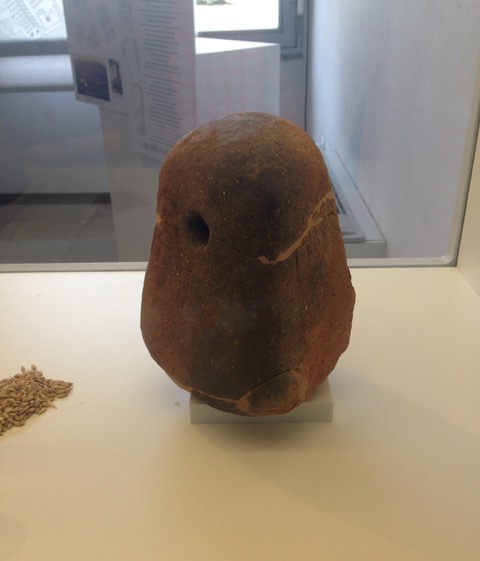Casazza: Cavellas archaeological area
In the archaeological area it is possible to walk through an ancient settlement, which has been handed over to us sealed under more than four metres of debris. This is a unique opportunity to discover daily life in a Roman village.
Cavellas is a Roman village discovered between 1987 and 1992 during the construction of the Migross Supermarket in Casazza, under which it was preserved and can now be visited: following a museum project, the site has been open to the public since 2015.
Going down the stairs, which can be reached from the supermarket car park, it is possible to visit the remains of an important settlement that arose in the 1st century AD at the bottom of the Cavallina valley, along the road that connected Bergomum with the Camonica valley and the Alpine passes: not far from Cavellas, the remains of a statio were also found, i.e. a resting and changing area for the horses that were used to travel along the ancient road axis.

The village of Cavellas had a long continuity of life, during which the houses were enlarged, raised in storey and modified to house the population that lived there: there was also an open space, where there was a well and community activities took place.
From the 6th century A.D. onwards, this settlement was abandoned due to fires and floods, as well as the continuous overflowing of the Drione stream, which flowed just above the settlement, making life in Cavellas impossible. In the Middle Ages, in fact, the village moved further upstream, probably near the church of San Lorenzo, known in sources as early as the 8th century. Over the centuries, the village of Cavellas was buried under more than 4 m of debris, which, however, protected the Roman remains and preserved them in excellent condition until today.

The archaeological area covers more than 1,000 square metres and, to date, has only been partially excavated: it is possible to walk inside the ancient vicus, formed by rectangular and quadrangular houses, placed side by side to define a unitary settlement. The houses have stone walls and floors of beaten earth, mortar or stone slabs that define the rooms, which are accessed by means of stone thresholds. Inside the houses, hearths have been found (leaning against the walls or centred in the rooms) used for the daily needs of the small community, which lived by exploiting the resources of the territory.
During the archaeological excavations, numerous artefacts were recovered, such as pots and pans, loom weights and millstones. These artefacts testify to the craft activities that took place in the village (farming, breeding, fishing and weaving) and are now visible in the archaeological area, displayed in a small Antiquarium with thematic showcases.

Percorsi didattici
Il Museo Cavellas ha sempre posto particolare attenzione al mondo dei ragazzi e della scuola, sviluppando negli anni proficue collaborazioni con diversi istituti; per questo sono state ideate alcune proposte didattiche rivolte alle scolaresche, mirate ad approfondire la conoscenza dell’archeologia e dell’antico abitato di Cavellas.
Il punto di partenza è sempre una visita interattiva all’area archeologica, dove sono musealizzati i resti del villaggio romano, condotta con linguaggio e metodo appropriati ai diversi target di età. A questa prima parte è possibile abbinare un’attività pratica, focalizzata su alcuni degli aspetti emersi durante l’osservazione guidata: il lavoro dell’archeologo e il ritrovamento dei reperti, la vita quotidiana, le attività artigianali, le tecniche costruttive, le credenze religiose degli abitanti di Cavellas e, più in generale, nel mondo romano.

In caso di richieste specifiche da parte degli insegnanti possono essere studiati particolari percorsi tematici, lezioni o approfondimenti, da svolgersi a scuola o presso lo spazio didattico dell’area archeologica. Il Museo Cavellas è inoltre aperto alla collaborazione con gli Istituti superiori per progetti e ricerche e per forme di alternanza scuola – lavoro.
Per ulteriori dettagli sui percorsi e i costi scarica la brochure o contatta i servizi educativi del museo: info@museocavellas.it – 3297197870.
Se vuoi conoscere meglio la val Cavallina, oltre all’offerta dedicata all’area archeologica Cavellas, nella brochure troverai informazioni anche sui percorsi che approfondiscono, in maniera divertente e istruttiva, le tematiche affrontate nel vicino museo storico – ambientale, che studia il rapporto tra le risorse naturali del territorio e il loro uso da parte dell’uomo.
Information
for the visit

Opening time
from March to December, Saturdays 3 p.m. – 6 p.m., Sundays 10 a.m. – 12.30 p.m., 3 p.m. – 6 p.m. During the closing period the archaelogical area is open by appointment. Guided tours for groups, also with interpreters, can be arranged by prior reservation.
Biglietti
- full 4 euros
- reduced 2 euros
- free based on conventions

Contacts
Via Nazionale 47, 24060 Casazza (BG) Telephone: 3297197870, e-mail: info@museocavellas.it
facebook/instagram: @museocavellas

Other information
Near the area there are a parking and a playground, parking for disabled people nearby.
Physical accessibility:
- presence of elevators
- possibility of using wheelchairs
- possibility of using aids for manual mobility
- bathroom for the disabled
- seating
Visually impaired:
- tactile experience (by reservation)
- braille panels









